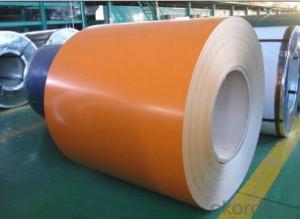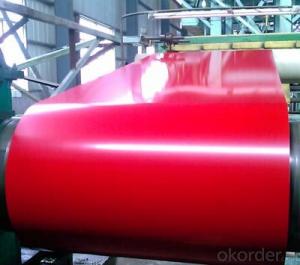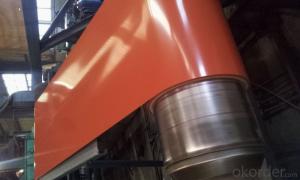Color coated steel coils PPGI PPGL
- Loading Port:
- Shanghai
- Payment Terms:
- TT OR LC
- Min Order Qty:
- 50 m.t.
- Supply Capability:
- 100000 m.t./month
OKorder Service Pledge
OKorder Financial Service
You Might Also Like
colour coated steel
painting colour steel , zinc coated steel , lead coated steel
Standard: | AISI,ASTM,BS,DIN,GB,JIS | Grade: | DX51D,SGCC,SPCC,CGCC | Thickness: | 0.17-1.5mm |
Place of Origin: | Taian China (Mainland) | Brand Name: | HengJi | Model Number: | HJ |
Type: | Steel Coil | Technique: | Cold Rolled | Surface Treatment: | RAL color cremated, oiled, skin passed |
Application: |
building metal roofing components,house appliance | Width: | 914-1250mm | Length: | customized |
price: | favorable price | Our Customers | Steel force, Stemcor, Duferco, Samsung , G&G,Hyosung,CNBM |
Packaging & Delivery
Packaging Detail: | standard export packing or customized |
Delivery Detail: | 15 days after prepayment |
Specifications:
galvanized steel coil:
1.Thickness:0.17mm-1.5mm
2.Zinc coated:40g-275g/2
3.Standard:dx51d+z,sgcc
We manufacture Galvanized Steel Coils,Pre-painted Galvanized Steel Coils , etc
Prepainted steel coil features:
1. Zinc coating :40-120g(as reauired)
2. thickness:0.17-1.2mm
3. width:914-1250mm(900mm,1215mm,1250mm,1000mm the most common)
4. coil id:508m610mm
5. coil weight: 3-12(as required)
6. surface treatment:RAL color
Galvanized steel coil features:
1. Zinc coating :40-275g( as required)
2. thickness:0.17-1.2mm
3. width:914-1250mm(900mm,1215mm,1250mm,1000mm the most common)
4. coil id:508m610mm
5. coil weight: 3-12(as required)
6. surface treatment: cremated, oiled, skin passed
7. Spangle: regular,small, zero
8.Application: With excellent cold bending molded manufacturablity, good decoration effect, strong anti-corrosion ability, galvanized steel coils and sheets are also pollution-free and easily recycled. Accordingly, they can be used as final products and basic plates of color coated steel coils and widely applied in construction, home appliances, decoration, ect.
Product name | steel coil,galvanized steel,galvanized steel coil |
Material | DX51D, SGCC, SPCC, CGCC, DX51D |
Normal thickness | 0.17-1.2mm |
Normal width | 900mm,914mm, 1000mm, 1200mm, 1220mm, 1250mm |
Coil weight | 3-12ns |
Certificate | BV & SGS |
Original | Shandong,China |
Payment terms | L/C or T/T |
Delivery time | within 15 ~ 25 days after 30% prepayment |
- Q: What are the protective coating options for steel strips?
- There are several protective coating options available for steel strips, including galvanization, powder coating, epoxy coating, and paint. These coatings help to prevent corrosion, improve durability, and enhance the aesthetic appearance of the steel strips.
- Q: Can steel strips be used in the production of sporting equipment?
- Yes, steel strips can be used in the production of sporting equipment. They are commonly utilized in various applications such as the construction of racket frames, golf club heads, and other sports equipment that require durability and strength.
- Q: What are the factors that affect the hardness of steel strips?
- The factors that affect the hardness of steel strips include the composition of the steel, the heat treatment process, the cooling rate, the presence of impurities, and the amount of strain or deformation applied during processing.
- Q: How are steel strips tested for tensile strength?
- Steel strips are tested for tensile strength using a method called tensile testing. This involves applying a pulling force to the strip until it breaks, while measuring the amount of force required to cause the break. The testing is typically conducted in a specialized machine called a tensile testing machine. To perform the test, a sample of the steel strip is prepared with a specific shape and size, usually in the form of a dog bone-shaped specimen. The specimen is then securely clamped into the grips of the tensile testing machine. One grip is attached to the upper part of the machine, while the other grip is attached to the lower part. Once the specimen is in place, the machine applies a steadily increasing force in the opposite direction of the clamps. This force causes the steel strip to stretch and elongate until it ultimately fractures. Throughout this process, the machine records the amount of force being applied and the corresponding elongation of the strip. The recorded data is plotted on a graph, known as a stress-strain curve, which shows the relationship between the applied force (stress) and the resulting deformation (strain) of the steel strip. The tensile strength of the strip is determined by identifying the maximum force it can withstand before breaking. Tensile testing provides valuable information about the mechanical properties of the steel strip, such as its ultimate tensile strength, yield strength, and elongation. These properties are essential for determining the suitability and quality of the steel strip for specific applications, such as in construction or manufacturing industries.
- Q: How are steel strips used in the manufacturing of storage tanks?
- Steel strips are commonly used in the manufacturing of storage tanks due to their strength, durability, and flexibility. These strips serve as the primary material for constructing the cylindrical body of the tank. Initially, the steel strips are cut into specific lengths and widths, depending on the desired size and capacity of the storage tank. They are then shaped into a cylindrical form and welded together to create a seamless structure. The welding process ensures the tank is leak-proof and capable of withstanding high pressure. The steel strips used in storage tank manufacturing are typically made from carbon steel, which offers excellent mechanical properties and corrosion resistance. This is crucial to ensure the tank can withstand the harsh conditions it may be exposed to, such as the storage of corrosive substances or extreme temperature variations. Additionally, the flexibility of steel strips allows for the customization of storage tanks, enabling manufacturers to create tanks of various sizes and shapes to meet specific storage requirements. The steel strips are also easy to transport and assemble on-site, making them a preferred choice in the manufacturing industry. Overall, steel strips play a crucial role in the construction of storage tanks by providing strength, durability, and flexibility, ensuring the safe and efficient storage of various substances.
- Q: How do steel strips handle thermal expansion?
- Steel strips handle thermal expansion by expanding when heated and contracting when cooled. This is due to the inherent property of steel to expand and contract with temperature changes.
- Q: What are the different types of coatings available for steel strips?
- There are several types of coatings available for steel strips, including galvanized coatings, zinc coatings, tin coatings, polymer coatings, and paint coatings. Each type of coating offers different levels of protection against corrosion and wear, depending on the specific requirements of the application.
- Q: Are steel strips resistant to rust or oxidation?
- Yes, steel strips are generally resistant to rust or oxidation due to the protective oxide layer formed on the surface of the steel, which acts as a barrier against moisture and oxygen.
- Q: Are steel strips suitable for making electrical transformers?
- Indeed, electrical transformers can be made using steel strips. The reason for the widespread use of steel in transformer construction lies in its exceptional magnetic permeability and low electrical resistance. By employing steel strips, a compact and efficient design for the transformer core can be achieved, enabling the smooth transfer of electrical energy between the primary and secondary windings. Moreover, steel strips offer durability and superior mechanical strength, guaranteeing the long-lasting performance of the transformer. Consequently, steel strips emerge as an apt option for the production of electrical transformers.
- Q: How do steel strips perform in frictional applications?
- Steel strips perform very well in frictional applications due to their high strength and durability. They have excellent resistance to wear and can withstand high levels of friction and heat without significant deformation or damage. Their smooth surface and uniform thickness also contribute to their excellent performance in reducing friction and ensuring reliable operation in various applications.
Send your message to us
Color coated steel coils PPGI PPGL
- Loading Port:
- Shanghai
- Payment Terms:
- TT OR LC
- Min Order Qty:
- 50 m.t.
- Supply Capability:
- 100000 m.t./month
OKorder Service Pledge
OKorder Financial Service
Similar products
Hot products
Hot Searches
Related keywords



























